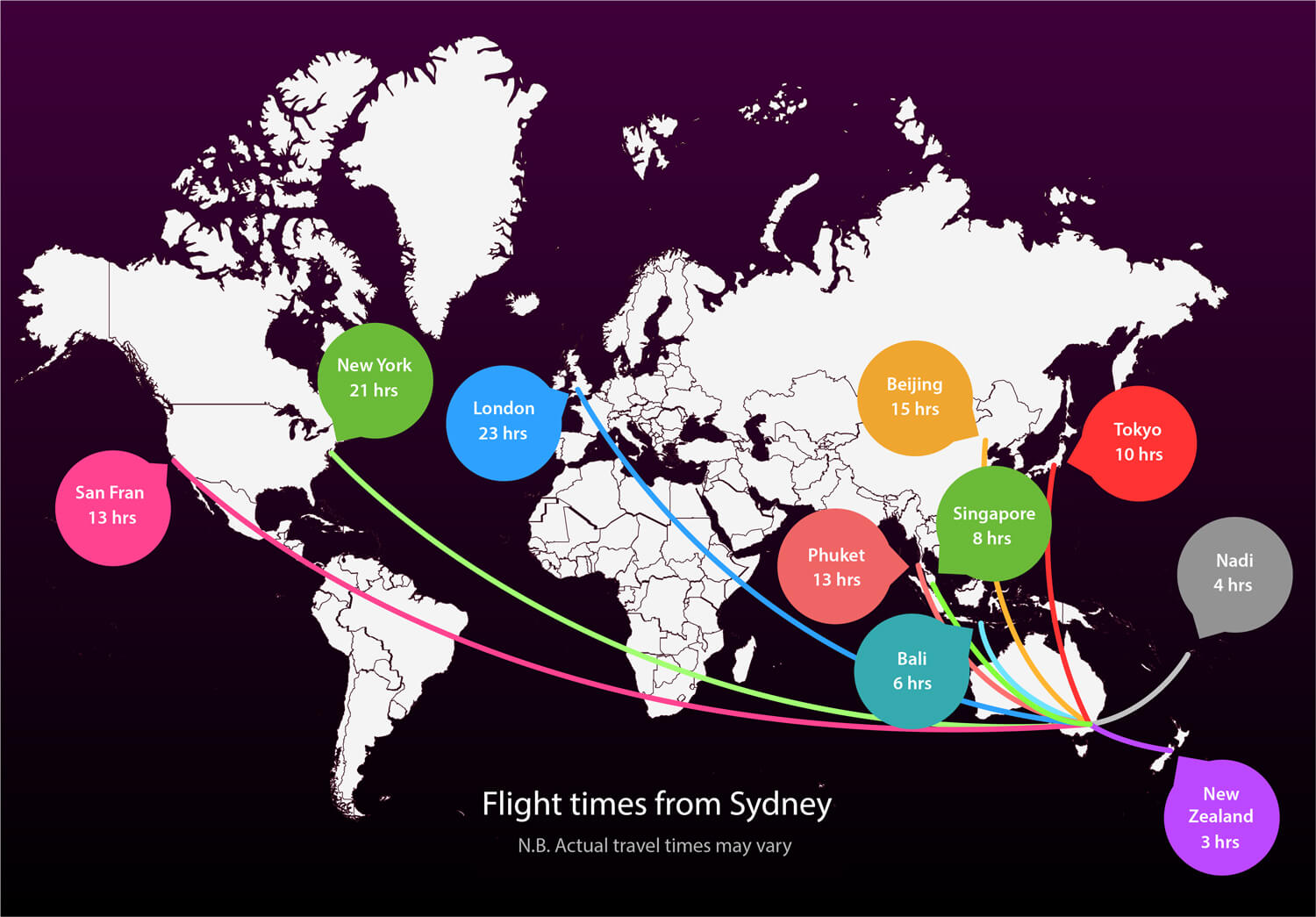
Many will never go on their dream holiday. They’ll daydream, saying ‘One day’, but then they’ll put it off for a time that may never come. Today, we’re saying no to that sentiment and yes to putting our money where our mouth is.
Perhaps you want to explore your own backyard or venture further abroad to soak in exotic destinations. The world is packed with stunning vistas, charming towns, and fascinating cultures just waiting to be discovered and enjoyed.
So, where do you get started? From booking accommodation to sorting out your passport or visa, planning that dream holiday can be somewhat overwhelming – not to mention that thought that often creeps in when you’re about to fall asleep at night: Have I forgotten something?
That’s why we’ve created the ultimate step-by-step travel guide for planning your dream holiday end-to-end. Take a look at the topics below to get started!
We’ve got you covered:
- Choose your destination
- Do your research
- Check your passport & visa requirements
- Protect your holiday
- Book flights & accommodation
- Visit your doctor
- Pack & secure your bags
- Plan how you’ll get around
- Make your travel budget fly further
1. Choose your dream destination
Ask your friends and family
When planning your vacation, the first step is to decide where you’d like to go and what you’d like to do. Are you looking to head overseas, or would you prefer to explore Australia? If you’re unsure, asking family and friends is often a good place to start as they can provide recommendations based on their own experiences and what they think you’ll enjoy. From these conversations, you may whittle down your list of potential destinations to your top five.
The most popular overseas travel destinations
If you are heading overseas, another way you can refine your list of potential destinations is to see where other Aussie travellers tend to frequent.
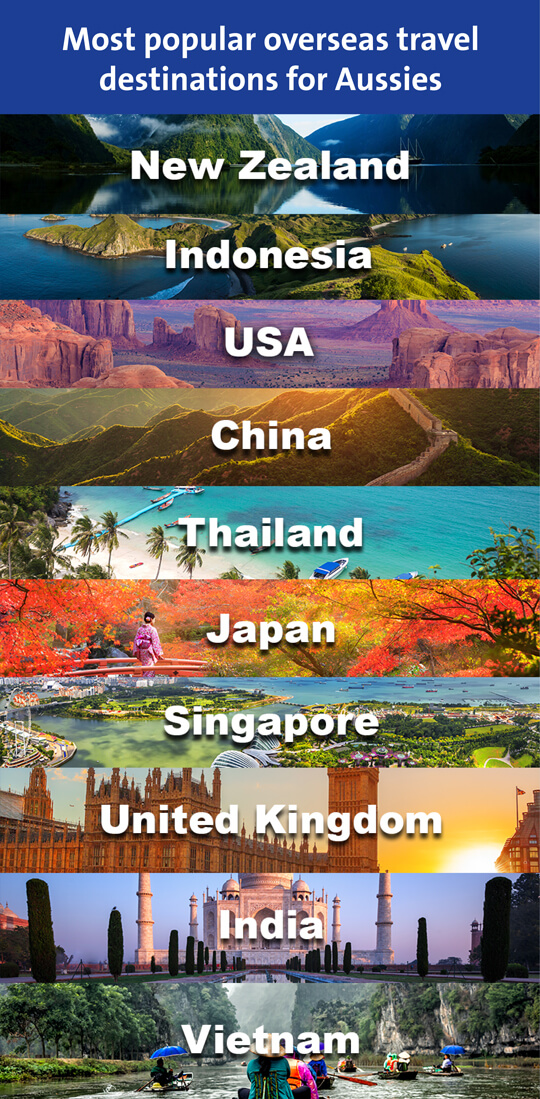
According to the Australian Bureau of Statistics (ABS), the most popular destinations for Australian residents from April 2017-18 were New Zealand, Indonesia, United States of America, China, Thailand, Japan, Singapore, United Kingdom, India, and Vietnam.
Overall, the highest percentage increases for short-term travellers were for Japan, India, and Vietnam, suggesting that these countries, in particular, were popular among Aussie travellers.
While these stats may give you an indication of where is popular with travellers, don’t feel limited by these suggestions. You should always base your travel list on destinations and experiences that’ll accommodate your bucket-list. Who knows; you may end up taking in the Northern Lights on the frosty edges of Iceland, or you may take in the grandeur of Uluru.
Your itinerary: What do you want to experience?
When you picture yourself on holiday, what do you envision? Do you see yourself stretching out under a shady palm tree as you doze to the sound of crashing waves? Or maybe your thirst for history will lead you down cobblestone streets paved with tales of the past?
To help you narrow down your list of destinations, you’ll have to weigh up whether or not the list offers the experiences on your bucket list.
Snow sports
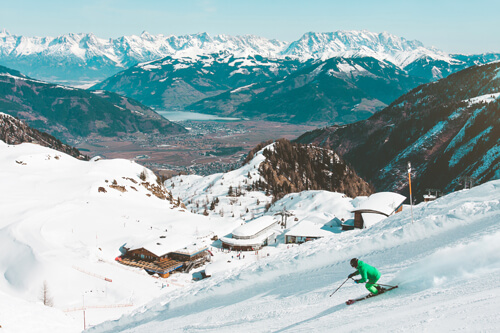
If skiing or snowboarding is your thing, heading to a country that offers fresh powder and plenty of ski runs is usually a safe bet. New Zealand’s South Island offers a vast range of skiing and snowboarding options. The Remarkables is home to great courses for beginners, and Coronet Peak is fantastic for intermediate to advanced skiers or snowboarders.
Japan is also home to great ski and snowboarding resorts, including the resort towns such as Hakuba and Niseko. Not only can you board or ski through some of the world’s best passages, but you can soak your muscles after a long day out on the mountains in a Japanese spa bath (onsen).
Diving

Diving is another popular sport that can help you pinpoint your ideal travel destination. Australia boasts the beautiful Great Barrier Reef, while Indonesia has some of the world’s best diving spots, with whale sharks, shipwrecks, manta rays and an array of unique sea life on display.
Sports

Are you an adrenaline junkie? New Zealand, and more specifically Queenstown, is often referred to as the adventure capital of the world, and with so many activities on offer, it’s obvious why! From bungee jumping to jet boating, parasailing to cycling – there’s everything for the budding daredevil.
History and culture
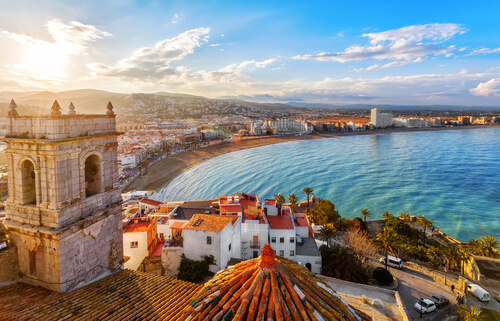
Plenty of historical charm makes Europe an ever-popular destination for Australians. The length of the flight is matched only by the long list of languages, and the diverse cultures and picturesque landscapes abound. Aussie favourites here are the United Kingdom, France, and Spain, but there is so much more to explore if you’re up for a little travelling.
As for cultural meccas, Japan is a hot holiday destination thanks to its high-tech cities, enchanting culture, and the allure of the unknown. From powdered ski slopes to soaking in an onsen (thermal spring), lush forests and ancient temples – there truly is something for all types of travellers here. Keep an eye on flights as well, as you may be able to nab an ultra-cheap ticket.
Beaches
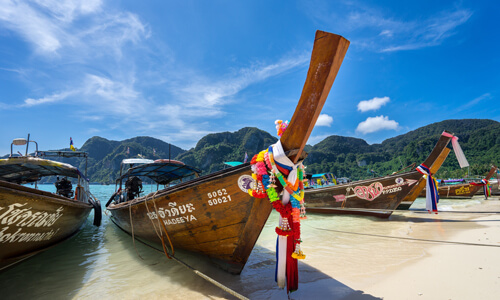
Keen to explore a tropical paradise? An island in Fiji could be just the ticket. If your budget is tight, but you’d still like to head overseas, Koh Samui, Ko Lanta, and Ko Chang in Thailand could also be a good bet. To learn more about those, check out our Thailand Map for Aussies.
If you’re planning a beach vacation in Australia, your choices are almost endless; Bay of Fires in Tasmania offers kilometres of powder-fine sand and clear waters, with the options of beachfront camping or luxurious eco-lodges. Noosa Heads also puts on a show, with beautiful beaches, trendy restaurant and shopping options on its famous Hastings Street, and an idyllic national park you can hike through when you’re seeking shelter from the Queensland sun.
Food
![]()
Why don’t you follow your appetite to a destination renowned for its delicious cuisine? Italy is one such favourite among Aussies, with its traditional Margherita pizzas (you won’t find pineapple on any pizzas in Italy), al dente spaghetti, and all flavours of gelato on practically every street corner.
Greece is another great destination that serves up its food with a view. Olive oil is like gold in this part of the world, and you’ll find it hard to get up from your table after you’ve indulged in some dolma or gyros filled with fresh meat and tzatziki. The Greek Islands are also famed for their locally-caught seafood.
Eat until you’re ready to siesta in Spain, with its cured meats, paella, bean stews, and the local favourite: empanada gallega – a savoury pie fit to bursting with minced pork and chorizo, or seafood and capsicum with slow-cooked onion sauce.
These are just some of the examples of great food our world has to offer. No matter where you go, though, your taste buds are bound to go wild.
2. Do your research
When will you be going?
The hemisphere and climate of your destinations will likely have a profound impact on your holiday plans. Some countries may experience extreme weather at different times of the year, from frigid or stifling temperatures to typhoons and cyclones. Getting caught out can be disastrous, so a little forethought and careful planning go a long way.
If you’re looking to ski, Japan usually showcases some of the best snow in the world from December to April. During this time, Japan transforms into a veritable wonderland. At the end of March, though, the rainy conditions can make for slushy snow. As such, it’s best to leave the ski resorts and head to the southern parts of the country, where cherry blossoms burst to life.
New Zealand also offers some great snowboarding and skiing opportunities from June to September. If you’d like to avoid crowds from other tourists and the country’s September school holidays, there may still be enough snow to enjoy in October.
For something a little warmer, Hawaii, Fiji, and Indonesia are wonderful destinations to enjoy. The glistening white sand and turquoise waters have a certain appeal, but it’s still important to do your research as these places often have wet and dry seasons to be aware of.
Another consideration is if the countries on your shortlist have any specific festivals or events you’d like to see on your travels.
How much time do you have?
Your length of stay will likely have a large impact on where you go. Maybe you can take a holiday whenever you please, or maybe your annual leave and other commitments have you limited to certain timeframes throughout the year?
If you’re looking for a week-long trip, far-flung places in Europe are likely to be off the cards due to cost and flight duration. However, if you’re heading away for three weeks or more, travelling in selected European countries or parts of North America could be an ideal vacation.
Bali is becoming an ever-popular destination for a long weekend. The dollar goes a long way, so costs can be kept to a minimum and flights are relatively short. However, you could just as easily stay longer, visiting other parts of Indonesia.
Be mindful that crossing multiple time zones often requires a little downtime to adjust. Take the below as a guide for the approximate flight times from Sydney to popular destinations around the globe.
If you’re planning to drive through Australia, try out our fuel comparison tool in the Simples app to ensure you’re stopping at cost-effective service stations.
Related: Guide to travelling with kids on a plane
Travelling solo, couple, group, or with the family
There are different things to consider depending on whether you’re flying solo, with another person, or with a group of family or friends.
Solo travel
Solo travel can be exhilarating, as you have the freedom to do as you choose, without having to worry about others in the group. You’re able to rest when you want, visit the landmarks that pique your interest the most, and you’re able to change your plans without consultation. Of course, there can be some downsides to going it alone. Depending on your personality, you may feel lonely at times, you don’t have an extra set of eyes on the bags, and you can’t split the bill over accommodation.
If you’re flying solo for the first time, you may find that an organised tour is a great way to relax and meet people, while still feeling like you’re getting out on your own.
Couple
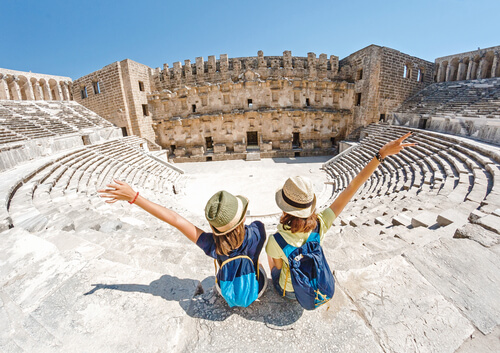
Travelling with a partner or close friend can be a blast, especially if you have similar interests. You’ve got a buddy there to share the laughs, holiday planning, and the cash flow.
To help ensure you’re both able to experience what you’d like and that you both have the same expectations for the trip, it’s handy to map out your itinerary together before you leave home. Don’t make your itinerary so strict that you can’t bend plans if you stumble upon a best-kept secret; instead, use it as a form of structure for your holiday and a decision-maker when you both can’t agree on where to eat.
Group travel
This can mean travelling in a group of friends or as part of an organised tour. Either way, it’s likely that your travels will be much more structured if you travel with a larger group of people. It’s certainly more difficult to make bookings and find vacancies for large groups on short notice, especially when it comes to booking accommodation, flights, or activities. As such, be sure to plan well in advance, so everyone is happy with the planned itinerary.
The larger the group, the more restricted you’re likely to be on how long you can go and when you can go.
Family adventures
Travelling as a family is an excellent way to bond by sharing experiences together. It’s amazing to see children take in new parts of the world with open wonder.
On the flipside, arguing kids can be hard to deal with if you’re spending your hard-earned savings on an annual trip. It can be normal to plan extensively when travelling with little ones; and if you’re going on a long-haul flight, their routine will be disrupted.
Travel carriers are helpful when little legs become tired, and a muslin cloth draped over a stroller can help block out sunshine so they can take their nap. An abundance of healthy snacks and bottled water is helpful in keeping hunger at bay during sightseeing. It pays to be organised when travelling as a family, particularly when there are young children in tow.
Your destination’s political and civil climate
Aside from researching your destination’s weather conditions and how the crowds will be during certain times of the year, it’s also important to research your holiday’s political and civil climate.
Smartraveller.gov.au provides travel warnings and advice to those planning on visiting other countries. Operated by the Department of Foreign Affairs and Trade (DFAT), this is a powerful tool that offers advice on the local laws, safety, security threats, and natural disasters. It also highlights any areas that are deemed unsafe to travel to.
It also provides tips in remaining safe in your place of travel, including advice on how you may avoid scams, and where you could receive medical attention if needed.
Before booking your flights or accommodation, be sure to stay across the news so you’re well aware of what’s going on in your destination.
3. Check your passport and visa requirements
Your passport
If you’re heading overseas, you won’t get very far if you don’t have a valid passport. As such, give yourself plenty of time to arrange your passport application or renewal. According to DFAT, you need to give yourself at least three weeks to receive a new passport. The more time you put aside for this process, however, the better.
Also be aware that if your passport’s pages are nearly or completely filled with stamps, you’ll need to obtain a new one – even if it’s still valid for a few more years.
Some countries require travellers’ passports to have at least six months’ validity beyond their planned visit. If your passport doesn’t, you could be refused entry.
Your visa
If you’re unsure if you require a visa, head over to Smartraveller.com.au. This government-run website can provide advice on whether or not you may need a visa. It’s important to take the information from Smartraveller as advice only, however, as it’s subject to change and may not cover your destination’s every travel consideration.
Check your destination’s embassy or consulate to be aware of any visa requirements, travel restrictions, or banned items. For instance, some countries will require you to have a visa before you travel, whereas others may allow you to apply for a visa upon arrival.
4. Protect your holiday
Take out travel insurance
Travel insurance may seem like an unnecessary expense, but it’s one that could save you from enormous out-of-pocket expenses if your flight is cancelled, your belongings and personal effects are stolen, or if you were to fall ill and require medical attention.
If you’re planning on going on a cruise, even if it’s travelling around Australia, it’s essential that you consider taking out cruise cover as an extra feature on your policy or as separate cover. Most cruise companies that operate ships in Australian waters recommend that their passengers purchase international travel insurance to ensure they have sufficient cover for any medical expenses they may incur – even if their cruise itinerary doesn’t include visits to international ports.

Any skiing or snowboarding must also be covered in your policy. As some policies don’t automatically cover winter sports, you may need to take this out as an add-on option to your policy if possible, or as an individual policy.
Those travelling throughout Australia can take out domestic travel insurance for protection against a range of events that can turn a holiday sour, like cancelled flights, theft, and car hire excess.
For further information on which type of travel insurance could suit your needs, take a look at our travel insurance page. No matter the type of holiday you’re about to embark on, it’s vital you talk to your insurer and carefully check your policy’s Product Disclosure Statement (PDS) to be aware of any cover limitations or exclusions.
Register your travel
Once you’ve worked out where you want to go and what you want to do, be sure to register your travel plans with the Department of Foreign Affairs and Trade (DFAT). By registering, DFAT may provide you with any updates that are relevant to your travel, and they may contact you or your family in the event of an emergency.
Photocopy your travel documents
Make copies of your travel documents as well as your itinerary, and hand these to a trusted family member or friend. Also make sure you pass along up-to-date contact details to your family and friends, as well as the best way for them to get in touch with you while you’re away, whether you’re staying overseas or in Australia.
5. Book flights and accommodation
Find great-value flights
Grabbing the best flight deal can be stressful, as it can be hard to know if you’ve found the best deal, or if a better price is just around the corner.
It’s often considerably cheaper to fly mid-week than on the weekend. Furthermore, early or late flights may prove better for your hip pocket, and you may experience fewer delays.
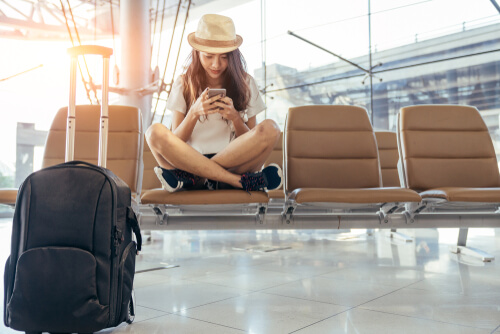
Google Flights is a particularly handy tool where you can search multiple destinations over a large area to see which airline is offering the best value. You may hit the jackpot, discover a new destination, or create a shortlist from your results.
Hopper is another app that allows you to compare current flight prices from some airlines to historical data so you can judge if tickets are likely to become cheaper. You can also set up alerts, so Hopper will let you know if there’s a great deal. Unfortunately, the app doesn’t compare some of the budget airlines at the moment, so you may have to check those out separately.
TIP: Some airlines have special sales on their websites, so it’s a good idea to check their site too.
Some of Australia’s cheaper airlines offer ‘take a friend for free’ or ‘get your return fare free’ deals only a few times throughout the year, and they sell out fast. The airlines often put deals on social media and in their newsletters, so be sure to sign up to their alerts, so you have a greater chance of snapping up a deal. When these offers do come along, there’s little time to procrastinate, as they could be gone before you know it.
Choose your accommodation
There is often a great variety of accommodation options when you’re travelling, from meeting people from all parts of the globe in a hostel to staying in a resort that caters to the whole family. Choosing what’s best for you will depend on your budget, personal requirements, the location, and the number of travellers in your group.
When planning your holiday accommodation, there are a few options you could consider:
Resort
Holiday resorts can cater to your every need and leave you with no desire to ever depart. From unlimited ice-cream for the kids, complimentary water sports, inclusive buffets, and cocktail happy hours; staying at a resort can be a great way to relax and recharge, with comfort at your fingertips.
Cruise
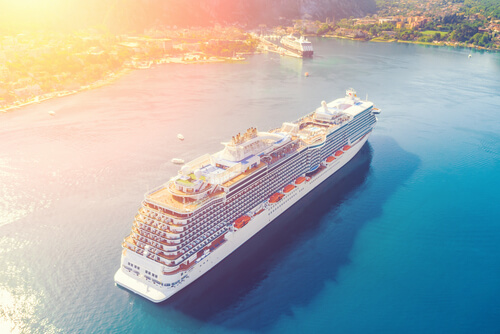
Taking to the ocean on a cruise can be a fantastic way to catch up on rest between ports while soaking in the ever-changing scenery. Nowadays, cruises can feature incredible water parks, theatres, and even sky-diving simulators. Along with different destinations to explore, your floating village takes care of the little things; all you need to worry about is being back on board with plenty of time before the cruise takes off for your next adventure.
Bed and breakfast
Staying in a B&B can be a good way to chat to locals and sample some home-prepared cuisine. B&Bs often accommodate fewer guests, so you may find it quieter and more secluded than a hotel.
Hostel
Hostels are popular with younger travellers as they are often cheap and offer basic amenities; like large, communal kitchens and shared bathroom facilities. Rooms are usually shared dorms of anywhere between four to 20 people. Typically, the more people per room, the cheaper the accommodation will cost.
Breakfast may be included in your accommodation costs, but it’s unlikely to be more than toast and basic cereals. If the lack of privacy doesn’t bother you, staying in a hostel is a great way to meet people from all over the world on a budget. Private rooms are an option if you’re willing to pay a little extra.
6. See your doctor
Get your travel vaccinations
You may require some travel vaccinations before you go on holiday, depending on the country you’re travelling to and its health risks.
According to Healthdirect, it’s important you see your doctor and receive any necessary vaccinations at least six weeks before you depart Australia. This timeframe is said to give you better protection from disease and infection while travelling.

When talking to your doctor, tell them exactly where you’ll be travelling to, how long you intend to stay, and which activities you’ll be joining.
Common vaccinations for travellers can include:
- Hepatitis A and B
- Typhoid
- Japanese encephalitis
- Yellow fever
- Tuberculosis (TB)
- Rabies
- Tetanus
Even if you have travelled to your destination before, Healthdirect still recommends you see your doctor, as you may require a booster or there may be new health concerns for the country you’re visiting.
Get a doctor’s note for any medication
If need to take any prescription medication overseas, even over-the-counter medicine, it’s a good idea to get your doctor to write a letter detailing the nature of the medicine, how much you’ll be taking, and whether or not your medicine is for personal use or for someone travelling with you, like a child. It’s also important to travel with all medicine in its original package to help with identification.
To ensure you’re not breaking any laws by bringing in certain medication, you should seek advice from your destination’s embassy or consulate.
7. Pack your bags

Here’s the highlight of the entire holiday: packing your bags!
No?
Okay, so while this part of the holiday planning can be the most frustrating, it’s important you pack in such a way where you meet your airline’s suitcase weight allowance while including all of the essentials.
Keeping your suitcase within its weight allowance can be tricky if you’re packing thick jumpers for a cold destination. If this is the case, it’s a good idea to take your heaviest, thickest coat with you on the plane as part of your carry-on luggage; you can always stow it away while on the plane. Besides, it gets quite cold on planes!
- Pack clothing in compression bags to create more room in your suitcase and to organise your belongings
- Try to reduce the number of shoes needed for your trip, as these can add substantial heft to your luggage.
- Pack body wash, shampoo & conditioner in travel-size bottles. Don’t forget to put these and any other liquids into sealable sandwich bags, in case they leak on the flight.
- Fix TSA (Transport Security Administration)-approved locks on every suitcase compartment to keep it as secure as possible. TSA locks allow customs to access your bag, if needed, with a master key. This means they won’t need to cut your zip or damage your suitcase to perform a security check.
- Place a name tag on your luggage as well as a ribbon around the handle, so your suitcase is easy to identify as your own.
8. Plan how you’ll get around
Use Google Maps offline
Before you leave home, be sure to download the map of the city/cities you’ll be travelling to (as it can be a big download, you may want to connect to your home WiFi). This means that when you get to your destination, you’ll be able to view the map in offline mode and still receive directions and travel suggestions without using any of your phone data.
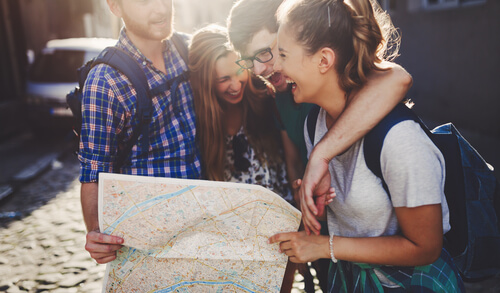
Research the local public transport system
Before you leave for your trip, research your destination’s public transportation system so you’ll know how you can get around once you land. Can you take advantage of a rail or bus system? Perhaps it’s better if you take a taxi or Uber? Or are you able to see most of your stops by foot?
Europe, in particular, is made up of relatively small countries that can be easily navigated by train with the Eurail pass. Spain, France, and Germany all have excellent rail networks, but other countries can also be crossed easily. You can even take the channel tunnel that connects the United Kingdom to France.
United States rail company Amtrak operates an extensive network allowing visitors to travel coast to coast by train. Different rail passes are available and are priced according to total duration and number of journeys.
Japan is famed for its bullet trains that run express from city to city, but the rest of the country is also well-connected with slower services. Visitors to Japan can buy a Railpass at rates locals could only dream of, but you have to make the purchase before entering the country. You can purchase a pass for differing trip durations and select the whole network of specified regional areas. Buses may be a better option in some places in East Asia, as a lot of trains are overcrowded.
Before you leave for your trip, be sure to research the public transport system of your destination, including any transport cards that may make travel easier.
9. Make your travel budget fly further
It can be challenging to save for your dream holiday, whether or not it’s domestic or international travel. However, there are little tricks that can help your budget fly further when you’re planning your travel and while you’re on holiday.
The amount you can spend is likely to directly impact where you go and how long for, so it’s worth doing a few sums so you know how much to budget for. Countries such as Thailand and Indonesia will likely require a smaller expenditure than more expensive locations, like New Zealand, Japan, and popular cities in the United States.

If your trip is a few months out, keep an eye on the exchange rate for your destination. Many currency exchange websites allow you to create an alert when the rate hits a set amount, such as this one from XE. If you take advantage of a decent exchange rate, you can make some significant savings.
If your budget is tight, you might consider compromising on one of your holiday requirements. Perhaps fly out of season, opt for inexpensive accommodation, or just go for a shorter period of time.
If your plans are set, and the savings goal is high, take a look at these top saving tips:
- Shop less. While this is obvious, it’s quite tough. If you’re used to buying new tech or clothes regularly, you may be surprised just how much cash you can save. If you want to buy something, wait for 30 days. It’s easy to impulse-buy, so waiting will help you decide if you really want the item.
- Cook at home. Making lunch for work and cooking dinner at home can save a fortune, especially if you’re getting your veggies at a bargain price at your local farmers’ market.
- Exercise for free. There are so many free ways to exercise, so if you’ve got serious saving goals, it might be time to wave goodbye to the gym membership. Walk to the train station, skip the lift and take the stairs, or smash out a weights session while you’re watching television.
- Start selling. This may seem extreme, but selling items you no longer need may generate some extra cash for your trip. You may even find it liberating to live a more clutter-free life!
- Limit your alcohol intake. Having a drink or two with a few friends on a Friday night can be a nice way to wind down, but it can eat into your savings. Either become privy to your local’s happy hour or forgo alcohol altogether.
- Switch off and maximise efficiency. Get into good energy habits and save money on your bill by switching off lights and turning off unused appliances at the wall. Also, switch your light bulbs over to more efficient options, or try to reduce the amount of time you’re using your air conditioner or heater. These changes can have a positive impact on your energy bills well after your vacation.
- Always eat everything in the fridge. Wasting food is like throwing money into the bin. Instead, use up everything you have in the fridge before you grocery shop again. It’s also helpful to go shopping on a full stomach, so you’re not tempted to give into cravings.
- Try to relax. Some find spending at the shops a fine way to relax, but this method will seriously hurt your holiday budget. Instead, switch the credit card for a good book and enjoy a healthy dose of sun at your local park. It can be tricky at first but just think of that money you’ll have for souvenir shopping when you’re finally on holiday.
